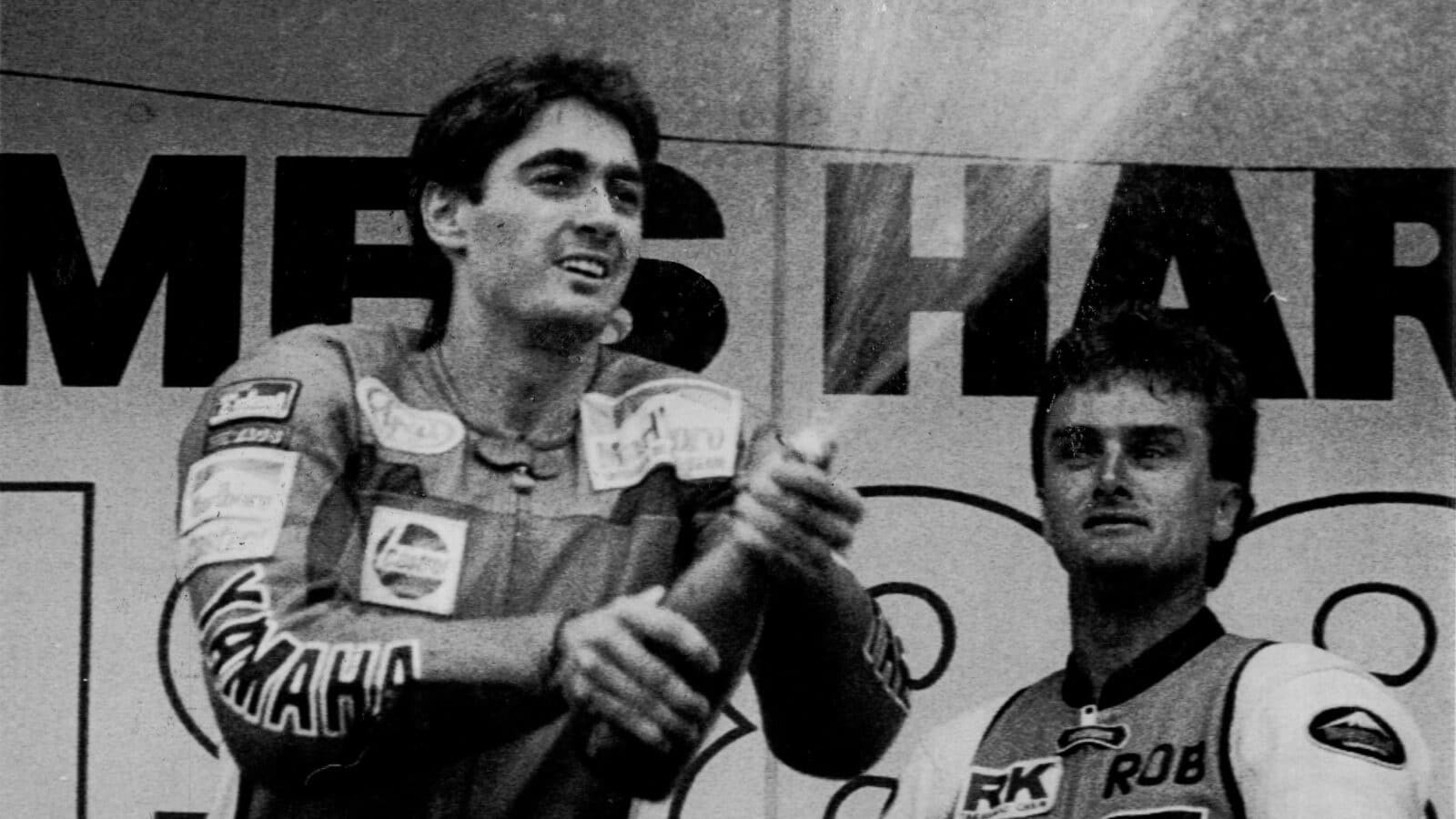Mat Oxley: Chance crash that kick-started Mick Doohan’s racing career
“Doohan’s strengths were a teak-tough psyche and a furnace of determination”

1988 successes, including at Bathurst (pictured) had teams knocking on Doohan's door
Fairfax Media via Getty Images
Mick Doohan, father of Alpine Formula 1 reserve driver Jack, won the last of his five consecutive MotoGP world championships 25 years ago. The Australian would almost certainly have won more but for injuries sustained in May 1999. That Jerez crash was the second life-changing accident of his career but this time there was no miracle comeback. It was time for retirement.
Doohan had ruled MotoGP with an iron fist for half a decade, riding 500cc two-strokes, which were so much nastier than today’s electronically managed 1000cc four-strokes. His strengths – remarkable riding talent, teak-tough psyche and a burning furnace of determination – had fans waking up on Sunday mornings wondering who would finish second.
When a journalist suggested to Doohan – never one to suffer fools gladly – that he was making grand prix racing boring by winning everything, he shot back, “What do you want me to do, slow down?”
And yet one of motorcycle racing’s all-time greatest careers might never have happened but for chance.
In the 1980s the paths to the top of motor sport were less clearly marked than they are today, so chance often played a part in a racer’s climb to the summit.
When Doohan was a kid his dad took him and his brothers racing, the three of them slewing their minibikes around oiled dirt tracks, which taught him everything he needed to know about finding traction. But their father died when Doohan was 12, and that was that, no more racing.
No surprise that Doohan became a bit of a wild thing, hooning around on road bikes and getting in trouble with the police.
But he appeared happy enough, doing factory jobs to earn a quid and partying hard, until one day a friend crashed his Yamaha RZ250 road bike. This was fate intervening.
The owner of the local motorcycle shop, who had been impressed watching young Doohan racing on a dirt track, offered to fix the bike for free so long as he entered it in a local production-bike event. Would Doohan have started racing again if his mate hadn’t trashed his bike? Who knows? Doohan raced the RZ and was soon practising and winning at the nearby Surfers Paradise track.
“He never used to check the tyre pressures or anything,” says younger brother Scott. “He’d be sliding around because he only had 15psi in the tyres, with his shirt hanging out between his two-piece leathers. He was a bit loose in those days – it was just all good fun.”
However, Doohan’s talent was there for all to see, so it wasn’t long before people were lending a hand. Businessman and bike nut Jon MacGillivray put Doohan on an RZ500 and had some interesting ideas to get the youngster noticed, like making Doohan wear baggy camouflage overalls over his leathers and naming their low-budget outfit Team Camo.
Japanese teams soon came calling, inviting Doohan to race in prestigious races like the Suzuka 8 Hours, which is where I first encountered him. During practice for the 1988 event he came past me at the hairpin, lit up the rear tyre of his factory Yamaha YZF750 and snaked gloriously out of the corner, smoke pouring off the tyre, controlling the fearsome zigzags by weighting each footpeg. Through the next fourth-gear right-hander he was fully sideways, smoke still pouring off the tyre. Wow!
“I realised then that the Honda wasn’t like the Yamaha”
Within months he had Honda, Suzuki and Yamaha chasing him for a 1989 MotoGP ride. He signed a letter of intent with Suzuki, tested the Yamaha and joined Honda, the biggest team of them all.
It didn’t take Doohan very long to wonder if he had made a dreadful mistake. He had a nasty crash when he first tested Honda’s fiery NSR500 and had several more accidents at the opening GPs.
“That was my wake-up call,” he says. “It was like, ‘Wow, so they call this a motorcycle, do they?!’ I realised then that the Honda wasn’t like the Yamaha. The Yamaha was just another motorcycle, whereas the Honda definitely wasn’t. I could see why WG [Wayne Gardner, 1987 MotoGP champ and his team-mate] was always getting spat off. I wasn’t 100% happy with the way things were going. I wasn’t getting a lot of feel from the bike and I’d been thrown down the road a few times. I was already thinking I’ve got to change the way I do things. I was feeling a bit cocky after the previous two years. I probably wasn’t preparing myself to go racing. I wasn’t 100% dedicated.”
Doohan stopped partying and started training, hard. By the start of 1990 he was a new man. His results improved. Honda started listening to his feedback, so the NSR also got better.
Doohan was on his way to the 1992 MotoGP title when he broke a leg, which doctors considered amputating after botching the surgery. Against the odds, he recovered to win the 1994 title and the next four.
His riding skills were out of this world – like, for instance, using the clutch for traction control.
“Once a two-stroke has got a gutful of fuel, rolling the throttle off won’t do anything, because it’s going to burn that fuel, so the engine is still going to spin the tyre. The clutch would instantly disengage the engine, so if it was getting too aggressive I could use the clutch to pull out some of the spin, because I knew that rolling off the throttle would be too slow.”
Mat Oxley has covered motorcycle racing for many years – and also has the distinction of being an Isle of Man TT winner
Follow Mat on Twitter @matoxley

